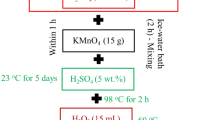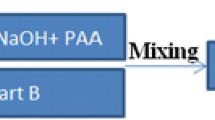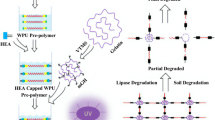Abstract
Maleate poly (vinyl alcohol) (PVAM)-graft water soluble polymer with deproteinized natural rubber (DPNR) porous materials were prepared using the freeze drying technique. The effect of the water soluble polymer type (chitosan (CS) and gelatin (GT)) and the DPNR content was studied. The mechanical properties of the porous materials were improved by the addition of the DPNR. The results showed that the addition of the DPNR improved the water resistance of the porous material. Many micro-voids were formed after the PVAM was grafted with the water soluble polymers as observed under SEM, leading to changes in porosity and density. The highest number of micro-voids was found in the PVAM-graft-chitosan (sPVAM-g-CS) sample while the minimum number of microvoids was found in the maleate poly (vinyl alcohol) (sPVAM). The swelling ratio of the nPVAM significantly improved after the freeze drying process. The PVAM-graft-gelatin (sPVAM-g-GT) gave the maximum swelling ratio in water. After the DPNR was added to the sPVAM-g-GT, the pore size of the porous material significantly decreased and the size distribution became narrower. The moisture absorption, moisture content and swelling ratio of the porous material decreased after blending with the DPNR but the tear strength and rebound resilience of the porous material was enhanced. The macroporous material was able to be reused the maximum number of over 30 times as organic compound-absorbent material and it easily decomposed in nature.
















Similar content being viewed by others
References
Sukhlaaied W, Riyajan S (2016) Green robust pH-temperature-sensitive maleated poly(vinyl alcohol)-g-gelatin for encapsulated capsaicin. Polym Bull 73:2303–2320
Shen Y, Gu J, Tan H, Lv S, Zhang Y (2016) Preparation and properties of a polyvinyl alcohol toughened urea-formaldehyde foam for thermal insulation applications. Constr Build Mater 120:104–111
Baghbanzadeh M, Rana D, Lan CQ, Matsuura T (2016) Effects of hydrophilic silica nanoparticles and backing material in improving the structure and performance of VMD PVDF membranes. Sep Purif Technol 157:60–71
Rezaei A, Tavanai H, Nasirpour A (2016) Fabrication of electrospun almond gum/PVA nanofibers as a thermostable delivery system for vanillin. Int J Biol Macromol 91:536–543
Chen GE, Xu SJ, Xu ZL, Zhu WW, Wu Q, Sun WG (2016) Preparation and characterization of a novel hydrophilic PVDF/PVA UF membrane modified by carboxylated multiwalled carbon nanotubes. Polym Eng Sci 56:955–967
Madyan OA, Fan M, Huang Z (2017) Functional clay aerogel composites through hydrophobic modification and architecture of layered clays. Appl Clay Sci 141:64–71
Niknia N, Kadkhodaee R (2017) Factors affecting microstructure, physicochemical and textural properties of a novel Gum tragacanth-PVA blend cryogel. Carbohydr Polym 155:475–482
Martínez-Gómez F, Guerrero J, Matsuhiro B, Pavez J (2017) In vitro release of metformin hydrochloride from sodium alginate/polyvinyl alcohol hydrogels. Carbohydr Polym 155:182–191
Wang W, Zhang X, Teng A, Liu A (2017) Mechanical reinforcement of gelatin hydrogel with nanofiber cellulose as a function of percolation concentration. Int J Biol Macromol 103:226–233
Piao Y, Chen B (2017) Synthesis and mechanical properties of double cross-linked gelatin-graphene oxide hydrogels. Int J Biol Macromol 101:791–798
Yuan L, Wu Y, Gu QS, El-Hamshary H, El-Newehy M, Mo X (2017) Injectable photo crosslinked enhanced double-network hydrogels from modified sodium alginate and gelatin. Int J Biol Macromol 96:569–577
Wan J, Zhu C, Hu J, Zhang TC, Richter-Egger D, Feng X, Zhou A, Tao T (2017) Zirconium-loaded magnetic interpenetrating network chitosan/poly(vinyl alcohol) hydrogels for phosphorus recovery from the aquatic environment. Appl Surf Sci 423:484–491
Xu Y, Yuan S, Han J, Lin H, Zhang X (2017) Design and fabrication of a chitosan hydrogel with gradient structures via a step-by-step cross-linking process. Carbohydr Polym 176:195–202
Li R, Liang W, Li M, Jiang S, Huang H, Zhang Z, Wang JJ, Awasthi MK (2017) Removal of Cd(II) and Cr(VI) ions by highly cross-linked Thiocarbohydrazide-chitosan gel. Int J Biol Macromol 104:1072–1081
Sukhlaaied W, Riyajan S (2014) Green synthesis and physical properties of poly(vinyl alcohol) maleated in an aqueous solutions. J Polym Environ 22:350–358
Sukhlaaied W, Riyajan S (2016) Preparation and properties of a novel environmentally friendly film from maleated poly(vinyl alcohol) grafted with chitosan in solution form: the effect of different production factors. Polym Bull 73:791–813
Riyajan S, Sukhlaaied W, Keawmang W (2015) Preparation and properties of a hydrogel of maleated poly(vinyl alcohol) (PVAM) grafted with cassava starch. Carbohydr Polym 122:301–307
Mishra YK, Adelung R (2018) ZnO tetrapod materials for functional applications. Mater Today 21:631–651
Nasajpour A, Mandla S, Shree S et al (2017) Nanostructured fibrous membranes with rose spike-like architecture. Nano Lett 17:6235–6240
Srivastava SK, Mishra YK (2018) Nanocarbon reinforced rubber nanocomposites: detailed insights about mechanical, dynamical mechanical properties, payne, and mullin effects. Nanomaterials 8(11):945
Sourbh T, Penny PG, Messai AM, Sigitas T, Mishra YK, Thakur VK (2017) Progress in lignin hydrogels and nanocomposites for water purification: future perspectives. Vacuum 146:342–355
Butylina S, Geng S, Oksman K (2016) Properties of as-prepared and freeze-dried hydrogels made from poly(vinyl alcohol) and cellulose nanocrystals using freeze-thaw technique. Eur Polym J 81:386–396
Luo P, Liu L, Xu W, Fan L, Nie M (2018) Preparation and characterization of aminated hyaluronic acid/oxidized hydroxyethyl cellulose hydrogel. Carbohydr Polym 199:170–177
Zhang Q, Liu X, Ren X, Duan L, Gao G (2018) Adenine-mediated adhesive and tough hydrogel based on hybrid crosslinking. Eur Polym J 106:139–147
Kawano A, Yamamoto K, Kadokawa JI (2017) Preparation of self-assembled chitin nanofiber-natural rubber composite sheets and porous materials. Biomolecule 7:47–58
Sukhlaaied W, Riyajan SA (2017) A novel pH and temperature-sensitive maleate poly(vinyl alcohol)-graft-isopropylacrylamide/natural rubber blend: preparation and properties. Polym Bull 74:803–821
Riyajan S, Sasithornsonti Y (2013) Chemical crosslink degradable PVA aqueous solution by potassium persulphate. J Polym Environ 21:472–478
Ghorbani F, Nojehdehian H, Zamanian A (2016) Physicochemical and mechanical properties of freeze cast hydroxyapatite-gelatin. Mater Sci Eng 69:208–220
Yao R, Yao Z, Zhou J (2017) Novel multi-configuration aniline/phytic acid based aerogel with directed higher performance. Mater Lett 198:206–209
Momin M, Kurhade S, Khanekar P, Mhatre S (2016) Novel biodegradable hydrogel sponge containing curcumin and honey for wound healing. J Wound Care 25:364–372
Kemal E, Adesanya KO, Deb S (2011) Phosphate based 2-hydroxyethyl methacrylate hydrogels for biomedical applications. J Mat Chem 21:2237–2245
Furst T, Piette M, Lechanteur A, Evrard B, Piel G (2015) Mucoadhesive cellulosic derivative sponges as drug delivery system for vaginal application. Eur J Pharm Biopharm 95:128–135
Correia CR, Reis RL, Mano JF (2015) Multiphasic, multistructured and hierarchical strategies for cartilage regeneration. Adv Exp Med Biol 881:143–160
Riyajan S (2017) Physical property testing of a novel hybrid natural rubber-graft-cassava starch/sodium alginate bead for encapsulating herbicide. Polym Test 58:300–307
Sajna VP, Mohanty S, Nayak SK (2017) Moisture absorption behavior of hybrid bionanocomposites of polylactic acid and evaluation of physicochemical properties. J Thermoplast Compos 30:521–544
Neumann IA, Flores-Sahagun THS, Ribeiro AM (2017) Biodegradable poly (L-lactic acid) (PLLA) and PLLA-3-arm blend membranes: the use of PLLA-3-arm as a plasticizer. Polym Test 60:84–93
Surya I, Ismail H, Azura AR (2015) The effect of alkanolamide loading on properties of carbon black-filled natural rubber (SMR-L), epoxidised natural rubber (ENR), and styrene-butadiene rubber (SBR) compounds. Polym Testing 42:208–214
Arrieta MP, López J, Ferrándiz S, Peltzer MA (2013) Characterization of PLA-limonene blends for food packaging applications. Polym Test 32:760–768
Sakulkaew K, Thomas AG, Busfield JJC (2011) The effect of the rate of strain on tearing in rubber. Polym Test 30:163–172
Wang J, Wei J (2017) Interpenetrating network hydrogels with high strength and transparency for potential use as external dressings. Mater Sci Eng 80:460–467
Luo RK, Wu X, Peng L (2015) Creep loading response and complete loading–unloading investigation of industrial anti-vibration systems. Polym Test 46:134–143
Ismali R, Mahadi ZA, Ishak IS (2018) The effect of carbon black filler to the mechanical properties of natural rubber as base isolation system. Earth Environ Sci 140(1):012133
Riyajan S, Liaw DJ, Tanaka Y, Sakdapipanich J (2007) Cationic cyclization of purified natural rubber in latex form with a trimethylsilyl triflate as a novel catalyst. J Appl Polym Sci 105:664–672
Wang Z, Ma H, Chu B, Hsiao BS (2017) Super-hydrophobic modification of porous natural polymer “luffa sponge” for oil absorption. Polymer 126:470–476
Riyajan S, Keawittarit P (2016) A novel natural rubber-graft-cassava starch foam for oil/gasohol absorption. Polym Int 65:491–502
Riyajan S-A (2018) Development of a novel pH-sensitive polymer matrix for drug encapsulation from maleated poly(vinyl alcohol) grafted with polyacrylamide. Polym Bull. https://doi.org/10.1007/s00289-018-2615-4
Riyajan S-A, Teprak AA (2019) Novel environmentally friendly biopolymer product from gelatin and natural rubber: effect of bagasse fiber and urea. J Polym Environ 27:225-233
Acknowledgements
The author gratefully acknowledges the financial support provided by Thammasat University Research Fund under the TU Research Scholar, Contract No.2/50/2018 and Center of Scientific Equipment for Advanced Research, Thammasat University and Center of Scientific Equipment, Faculty of Science and Technology Tammasat University. This study was supported by The Thailand Research Fund/Prince of Songkla University/Thammasat University for financial support (RSA5780018) and Thammasat University and The Royal Golden Jubilee Ph.D. Program (2.L.PS/53/C.1.N.XX).
Author information
Authors and Affiliations
Corresponding author
Additional information
Publisher's Note
Springer Nature remains neutral with regard to jurisdictional claims in published maps and institutional affiliations.
Rights and permissions
About this article
Cite this article
Riyajan, SA., Sukhlaaied, W. Fabrication and Properties of a Novel Porous Material from Biopolymer and Natural Rubber for Organic Compound Absorption. J Polym Environ 27, 1918–1936 (2019). https://doi.org/10.1007/s10924-019-01474-3
Published:
Issue Date:
DOI: https://doi.org/10.1007/s10924-019-01474-3




